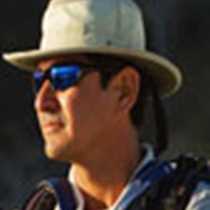Southern Isabela Island
It has been truly a wonderful day! Early in the morning we started our day at the southern side of Isabela Island, the largest of the archipelago. Many choices were given to our guests, so everyone could take advantage of their time. Some of us went for a long, seven miles walk to a volcano known as Sierra Negra. The enchanted colors of the surrounding vegetation captivated our guests and the feeble yellow and white flowers from one of many endemic plants was one of the many eye catching things that we found while on our walk. As we walked into the garua (local name for a very fine type of mist), we felt far from civilization and very close to our inner self. We could say that quietness was our companion until we suddenly saw the cloud of mist briefly disappear, unveiling in front of our eyes a breathtaking caldera, one of the largest in the world.
Meanwhile down below at sea level, a more leisure choice was taken by the rest of the guests. A panga ride along the coast, followed by a short walk into the volcanic landscape of tintoreras (the shark place), gave us more than the view of sharks. Penguins and blue footed boobies were adorning the scenery, just to mention a few.
For our afternoon activity we had organized a visit to one of the branches of the Charles Darwin Foundation and National Park programs on the island. The local giant tortoise’s breeding center holds a significant number of young baby tortoises. These babies were born in captivity, but with time, they would represent the cause of the survival of this species in the wild. Many adults are also found in the nearby enclosures, which have been saved from potential threats in the areas that they normally inhabit. These adults’ tortoises are now the main sources of babies being born at the center.
It has been truly a wonderful day! Early in the morning we started our day at the southern side of Isabela Island, the largest of the archipelago. Many choices were given to our guests, so everyone could take advantage of their time. Some of us went for a long, seven miles walk to a volcano known as Sierra Negra. The enchanted colors of the surrounding vegetation captivated our guests and the feeble yellow and white flowers from one of many endemic plants was one of the many eye catching things that we found while on our walk. As we walked into the garua (local name for a very fine type of mist), we felt far from civilization and very close to our inner self. We could say that quietness was our companion until we suddenly saw the cloud of mist briefly disappear, unveiling in front of our eyes a breathtaking caldera, one of the largest in the world.
Meanwhile down below at sea level, a more leisure choice was taken by the rest of the guests. A panga ride along the coast, followed by a short walk into the volcanic landscape of tintoreras (the shark place), gave us more than the view of sharks. Penguins and blue footed boobies were adorning the scenery, just to mention a few.
For our afternoon activity we had organized a visit to one of the branches of the Charles Darwin Foundation and National Park programs on the island. The local giant tortoise’s breeding center holds a significant number of young baby tortoises. These babies were born in captivity, but with time, they would represent the cause of the survival of this species in the wild. Many adults are also found in the nearby enclosures, which have been saved from potential threats in the areas that they normally inhabit. These adults’ tortoises are now the main sources of babies being born at the center.




